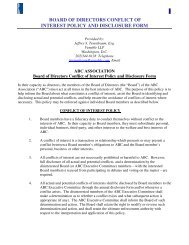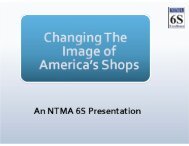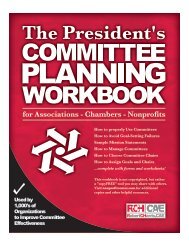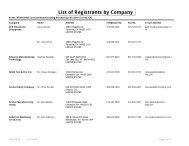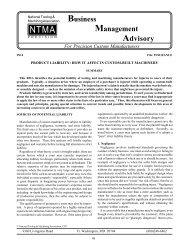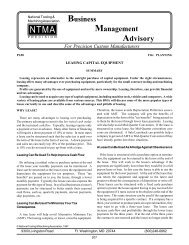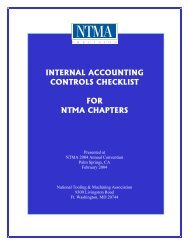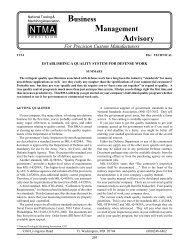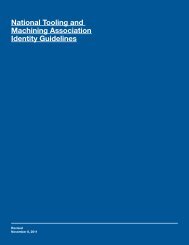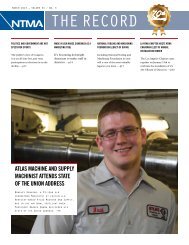A GENERAL DEFINITION - National Tooling and Machining ...
A GENERAL DEFINITION - National Tooling and Machining ...
A GENERAL DEFINITION - National Tooling and Machining ...
- No tags were found...
Create successful ePaper yourself
Turn your PDF publications into a flip-book with our unique Google optimized e-Paper software.
<strong>National</strong> <strong>Tooling</strong> &<strong>Machining</strong> AssociationNTMAP R E C I S I O NBusinessManagementAdvisoryFor Precision Custom ManufacturersTX06File:TAXESI..II.A DEPRECIATION GUIDE FOR TOOLING AND MACHINING COMPANY OWNERSDEPRECIATION - A <strong>GENERAL</strong> <strong>DEFINITION</strong>Depreciation is a system of accounting that distributesthe cost of capital assets over their estimateduseful lives in a systematic <strong>and</strong> rational manner. Theprimary thrust of the theory of depreciation is tomatch the deduction for exhaustion, wear <strong>and</strong> tear,<strong>and</strong> normal obsolescence of property with the incomeproduced from the use of the assets. The conceptseems simple, but the rules under the InternalRevenue Code keep changing. In recent years, theInternal Revenue Code has had four differentdepreciation systems. Depending upon the age of aparticular business, there may be a number ofdifferent depreciation systems at work simultaneouslyin any one business.THE HISTORY OF DEPRECIATIONDEDUCTIONSThe amount of the annual depreciation deduction isprimarily the product of two variables: the asset’suseful life in the business <strong>and</strong> the method forallocating the deduction to each period.A. Useful Life of AssetsThe total length of an asset’s life will affect theamount of the depreciation deduction in eachaccounting period of the business. The asset’s life isinversely proportional to the amount of the deductionin each period. The shorter the asset’s life, thelarger the deduction will be in each period. Thelonger the asset’s life, the smaller the deduction willbe in each period.1. Reasonable Method (1913-1962)The Revenue Act of 1913 allowed the taxpayer toselect freely any “reasonable period” for© <strong>National</strong> <strong>Tooling</strong> & <strong>Machining</strong> Association, 19979300 Livingston Road Ft. Washington, MD 20744 (800)248-6862249depreciation. This loose language led to aconstant tug of war between the taxpayers <strong>and</strong>the Department of Treasury.2. Bulletin F-1942As the Treasury received greater authority fromCongress during the Depression, it began toimpose administrative guidelines that restrictedthe taxpayer’s right to select “reasonableperiods.” These administrative guidelines weredetailed in a seemingly endless list of assets inBulletin F. The Treasury Department listedseparate lives of each asset <strong>and</strong> often changedthe life of an asset from industry to industry.3. Revenue Procedure Guidelines (1962-1970)In the 1960s, the Internal Revenue Service beganissuing Revenue Procedures, which groupedassets into broad, industry-wide classifications.Approximately 75 classes of assets were created.Each class was assigned a guideline useful life,which was 30 to 40 percent shorter than theapplicable lives listed in Bulletin F. The intent ofthe class life system was to reduce the number ofcontroversies between taxpayers <strong>and</strong> theInternal Revenue Service over the definition of“reasonable period.”4. Class Life Asset Depreciation Range System(ADR) (1971-1980)Prior to 1971, taxpayers had a great deal offreedom in determining both the useful life <strong>and</strong>method of depreciation for assets utilized in theirbusinesses. The Internal Revenue Service wasplaced in a difficult administrative position, sincethe taxpayer’s <strong>and</strong> the Service’s definition of“reasonable period” often differed drastically. Inan effort to reduce the number of such disputes,
the Internal Revenue Act of 1971 authorized thecreation of the ADR system. Under this system,class lives or asset guideline periods areprovided for broad classes of assets. The ADRsystem generally applies to all assets placed inservice after December 31, 1970 <strong>and</strong> beforeJanuary 1, 1981.B. Depreciation Methods1. Straight-LineBefore 1954, taxpayers commonly used theStraight-Line Method of Depreciation. Straightlinedivides the depreciable cost of an assetequally over each period within the assets usefullife.2. Accelerated MethodsThe Internal Revenue Code of 1954 authorizedthe utilization of two accelerated methods: thedeclining balance method <strong>and</strong> the Sum-of-the-Years-Digits Method. Each of these methodsattempted to recognize the fact that actualeconomic depreciation is greater in earlier yearsthan in later years. Each method acted to shiftmore of the depreciation deduction onto theearlier years.C. Cost Recovery in the 1980sIII.after 1980 <strong>and</strong> before January 1, 1987. Basicallythis system allows for the rapid recovery of thecost of assets using fixed recovery schedulesover a prescribed statutory period. It is muchsimpler to use than the ADR system since itdoes not require the taxpayer to estimate thedepreciable property’s useful life in salvagevalue.2. Modified Accelerated Cost Recovery System(MACRS) - 1986In 1986, Congress again revised st<strong>and</strong>ardizedlives; however, this time it spread the deductionfor depreciation over more years with theintroduction of the modified cost recoverysystem (MACRS). Under the MACRS, assetsare grouped into recovery periods that are basedupon the asset depreciation range (ADR)system, which was originally created in the1970s. The cost of depreciable personalproperty is generally recoverable over a 3-, 5-, 7-,10-, 15-, or 20-year period, depending uponwhich class it falls into. Real property willgenerally fall into either a 2.75 or 39-year classlife. Since MACRS applies to most depreciable,property placed in service after 1986, we willconcentrate the remainder of our discussion onthe current depreciation rules.CURRENT DEPRECIATION RULESPrior to 1981, depreciation changes were eitherrelated solely to the useful life of assets or themethod of depreciation. Under the Reagan administration,Congress acted to change depreciation onboth fronts at the same time.1. Accelerated Cost Recovery System (ACRS) -1981In 1981, Congress introduced the AcceleratedCost Recovery System (ACRS) in an effort tost<strong>and</strong>ardize asset lives <strong>and</strong> accelerate depreciationdeductions. Under the ACRS system,assets were grouped into general classes.Personal property groupings included thefollowing: three years for automobiles <strong>and</strong> lighttrucks, five years for furniture <strong>and</strong> equipment;<strong>and</strong> 15 years for other public utility equipment;ten years for railroad tank cars, mobile homes,<strong>and</strong> certain public utility equipment; <strong>and</strong> 15years for other public utility equipment. Realproperty, such as buildings <strong>and</strong> additions tobuildings, was originally placed in a 15-yearclass; this period was subsequently lengthenedto 18 <strong>and</strong> 19 years, respectively.The accelerated cost recovery system (ACRS)generally applies to property placed in serviceThe Modified Accelerated Cost Recovery System(MACRS) is an entirely new system of depreciation.The deduction for depreciation under MACRS is aproduct of three variables: useful life (the applicablerecovery period), the applicable method, <strong>and</strong> theapplicable convention.A. Applicable Recovery PeriodsRecoveryPeriodMACRS utilizes the ADR class life system created in1971 for the purpose of making recovery periodclassifications.The following table lists the MACRS RecoveryPeriods for various assets:Description3 years ADR midpoint life of four years <strong>and</strong> less,excluding cars <strong>and</strong> light trucks.5 years ADR midpoint life of more than 4 years <strong>and</strong>less than 10 years; plus cars <strong>and</strong> light trucks,qualified technological equipment, certainresearch <strong>and</strong> development (R&D) property.250
RecoveryPeriodDescription7 years ADR midpoint life of more than 10 years <strong>and</strong>less than 16 years; plus personal propertywithout an ADR life.10 years ADR midpoint life of more than 16 years <strong>and</strong>less than 20 years.The class lives of specific assets are generally published bythe Internal Revenue Service in periodic editions of TheInternal Revenue Bulletin as Revenue Procedures. The RevenueProcedures list assets by industry groupings, a narrativedescription, an ADR <strong>and</strong> by an Alternative Depreciation System(ADS) recovery period (which is for Alternative MinimumTax (AMT) purposes). The Revenue Procedures are updatedby the Internal Revenue Service on a not-less-than-annualbasis.15 years ADR midpoint life of more than 20 years <strong>and</strong>less than 25 years.20 years ADR midpoint life of more than 25 years forpersonal property.27.5 years Residential rental property39 years Nonresidential real propertyThe following is a sample from Rev. Proc. 87-56, 1987-42 CB 17 of specific assets that are common to tooling <strong>and</strong> machiningcompanies:Common MACRS Class AssetsClass GeneralAlternateDepreciation Rev. Proc. DepreciationSystem 87-56 Class System Life Description3-year 00.26 4 Tractor units (over-the-road)30.11 4 Special tools <strong>and</strong> devices used in manufacture of rubber;30.21 3.5 Special tools used in the manufacture of finished plastic products;32.11 2.5 Special tools used in the manufacture of glass products;34.01 3 Special tools used in the manufacture of fabricated metal products; <strong>and</strong>37.12 3 Special tools used in the manufacture of motor vehicles.“Special tools” includes jigs, dies, fixtures, mold patterns, gauges <strong>and</strong>special shipping devices. Does not include general-purpose, smalltools such as wrenches <strong>and</strong> drills or other general-purpose equipment.5-year 00.22 5 Automobiles <strong>and</strong> taxis.00.241 5 Light, general-purpose trucks (less than 13,000 lbs.).00.242 6 Heavy, general-purpose trucks.00.12 5 Information systems - computers <strong>and</strong> peripheral equipment.00.13 6 Data h<strong>and</strong>ling equipment - typewriters, calculators, adding machines,copiers, <strong>and</strong> duplicating equipment.00.21 6 Noncommercial airplanes <strong>and</strong> all helicopters.28.0 9.5 Assets used to manufacture basic organic <strong>and</strong> inorganic chemicals.Also includes assets used to manufacture photographic supplies suchas film, developing paper <strong>and</strong> developing chemicals.37.33 6.5 Special tool used in ship <strong>and</strong> boat building.B 5 Qualified technological equipment - computer <strong>and</strong> peripheral equipment,hi-tech telephone station equipment installed on customerpremises <strong>and</strong> hi-tech medical equipment.C -* R&D property in Sec. 168(e)(3)(b).15.0 6 Construction equipment.7-year 00.11 10 Office furniture, desks, files, safes, fixtures <strong>and</strong> equipment (includingcertain communications equipment).10-year 00.28 18 Vessels, barges, tugs, <strong>and</strong> similar water transportation equipment.* Use class life or 12 years.251
B. Applicable MethodPersonal property under MACRS is generallycalculated using the 200 percent declining balancemethod, with a switch to the straight-line methodduring the first year in which straight-line will yield alarger deduction.The applicable method for 15-year <strong>and</strong> 20-yearproperty is the 150% declining balance method, witha similar provision for switching to the straight-linemethod.The applicable method for both residential <strong>and</strong>nonresidential real property is the straight-linemethod. However, a taxpayer can voluntarily electstraight-line depreciation for any MACRS propertyas long as the election extends to all property of thesame class <strong>and</strong> is placed in service during the year ofthe election.C. Applicable Convention1. Personal PropertyMACRS personal property placed in service (ordisposed of) during any taxable year is treated asif it were placed in service (or disposed of) onthe midpoint of that year. This is called the halfyearconvention.The IRS depreciation tables factor this conventionin by allowing only one-half of the 200percent declining balance amount in the firstyear (See D).2. Real PropertyMACRS real property is generally treated as if itwere placed in service (or disposed of) on themidpoint of the month in which it is placed inservice (or disposed of). This is called the midmonthconvention.3. The Mid-Quarter Exceptiona. If the aggregate basis of property placed inservice during the last three months of the fiscalyear is more than 40 percent of the aggregatedbasis of property placed in service during theentire fiscal year, then a mid-quarter conventionis used.b. Nonresidential real property <strong>and</strong> residential rentalproperty are not taken into account for purposesof determining whether the mid-quarter conventionapplies; nor does that convention apply tosuch property, even if the convention is otherwiseapplicable.D. IRS Depreciation TablesThe following table lists the applicable percentageof cost, which is recoverable as depreciation foreach year under the 200 percent declining balancemethod, utilizing the mid-year convention.IRS Depreciation TablesRecovery 3-Year 5-Year 7-Year 10-YearYear Class Class Class Class1 33.00 20.00 14.28 10.002 45.00 32.00 24.49 18.003 15.00 19.20 17.49 14.404 7.00 11.52 12.49 11.525 11.52 8.93 9.226 5.76 8.93 7.377 8.93 6.558 4.46 6.559 6.5510 6.5511 3.29Similar tables are published in Rev. Proc. 87-56,1987-2 IRB 674, <strong>and</strong> Rev. Proc. 87-57, 1987-2 IRB 687,for the mid-quarter <strong>and</strong> mid-month conventions.E. First-Year Election to Expense (Section 179)Historically, taxpayers have been able to elect toexpense up to $17,500 of the cost of personalproperty used in a trade or business provided thatthe amount expensed does not exceed the incomederived from any active trade or business."This limitation of $17,500 has been increased instages to $25,000 in the year 2003 by the1986 TaxAct. The new limitations are as follows:Tax Year Beginning InMaximum Expense Deduction1997 $18,0001998 $18,5001999 $19,0002000 $20,0002001 - 2002 $24,0002003 $25,000Furthermore the amount of the deduction is increasedby $20,000 for property used by a businesslocated in an empowerment zone.Any nondeductible portion may be carried forwardsubject to the annual limit (IRC Section 179(b)(3), asamended by TAMRA). In order to qualify for theSection 179 deduction, the taxpayer must materiallyparticipate in the business (IRC Section 179 (d)(1)).252
EXAMPLEThe annual ceiling is reduced dollar for dollar fortaxpayers whose total investment in tangiblepersonal property is greater than $200,000. Furthermore,if the property is converted to non-businessuse prior to the end of the property’s recoveryperiod, the difference between expensing <strong>and</strong> theallowable MACRS deductions is recaptured.A corporation conducting an active business purchases <strong>and</strong>places in service $201,000 of Section 179 property during 1996.However, its taxable income before the Section 179 deductionis $6,000. The limitation would be applied as follows:1. Apply the $17,500 limit of Sec. 179(b)(1).2. Reduce the $17,500 by the amount of property acquiredin excess of $200,000 under Sec. 179(b)(2). In this case,the limit is $16,500 [$201,000 - $200,000 = $1,000].3. Apply the limit under Sec. 179(b)(3). In this case, thededuction is limited to $6,000. The amount of thecarryover is $10,500 [$16,500 - $6,000].F. Special Rules1. Salvage ValueThere is no salvage value recognized underMACRS.2. AutomobilesAn auto must be written off over a five-yearperiod. Depreciation for luxury automobilesplaced in service in 1996 with a cost in excess of$12,685 cannot exceed the following amounts:YearAmount1* $3,0602 4,9003 2,9504** 1,775* Year placed in service.** And each succeeding year.truck will not realistically last for five years. The best estimateis that the truck will last for about 200,000 miles (or about threeyears, based on estimated use). If the taxpayer locked into afive-year life?No. He can elect out of MACRS <strong>and</strong> depreciate the truck atthe rate of 10 cents per mile (the $20,000 cost divided by 200,000- the estimated miles the truck will last). For example, if the truckis driven for 80,000 miles in the first year, the depreciation forthat year would be $8,000 (10 cents X 80,000 miles).The right to use this mileage method is found in the InternalRevenue Code (the Code). Section 168(f)(1)(B) tells the taxpayerhe can use the unit-of-production method or any methodof depreciation not expressed in a term of years.EXAMPLE4. Additions <strong>and</strong> ImprovementsIn general, depreciation on additions or improvementsis computed in the same manner as theproperty to which the addition or improvement isadded would be depreciated if it were currentlyplaced in service under MACRS.Taxpayer owns <strong>and</strong> operates its plant, which was placed inservice in 1981 <strong>and</strong> is being depreciated under ACRS over aperiod of 15 years. The taxpayer constructs an addition to thebuilding in 1994. The addition should be depreciated underMACRS over 39 years.5. Lessee’s Leasehold ImprovementsPrior to the start of MACRS, lessees couldrecover the cost of leasehold improvements overthe shorter of the ACRS recovery period of theremaining terms of the lease. Under MACRS,lessees are treated as any other owner/taxpayerfor purposes of determining recovery deductionsfor lessee’s improvements. Therefore, thedepreciation deduction will be determinedwithout regard to the lease term. Accordingly,with regard to any leasehold improvement thatwould be subject to a 39 year life if placed inservice by the owner of the property, it nowmust be amortized by the lessee over a 39 yearlife, irrespective of his remaining lease term. Anyunamortized cost remaining at the end of thelease term may be deducted in full at that time.EXAMPLENote:If non-business use of the auto exceeds 50 percent,the depreciation deductions must be computed usingthe Alternative Depreciation System (ADS).3. Optional Allowance for Actual UseThe taxpayer buys a heavy truck for $20,000, which isconsidered to be five-year property under MACRS, but the2536. MACRS Cost Recovery Procedures for ShortTaxable YearsThe IRS has issued guidelines for computingdepreciation allowances for tangible propertywhen property is placed in service in a taxableyear consisting of less than 12 months. Rev.Proc. 89-15, IRB 1989-9 also covers situations inwhich property is disposed of prior to the end ofthe recovery period <strong>and</strong> when the recoveryperiod for the property includes all or part of a
IV.short taxable year other than the year theproperty is placed in service.The special rules of Rev. Proc. 89-15 apply ineach of the following situations:a. In the first year of new business entities,b. In the last year of a partnership <strong>and</strong> corporations,c. Wherever a taxpayer changes its fiscal year,d. When a partner in a partnership dies or a basiselection is made by a partnership, ore. Whenever property is transferred to a partnershipor a controlled corporation.ALTERNATIVE DEPRECIATION SYSTEM(ADS)An alternative cost recovery system has beencreated under MACRS for the purpose of applyingthe Alternative Minimum Tax (AMT) provisions,computing Adjusted Current Earnings (ACE) of adomestic corporation, <strong>and</strong> computing the depreciationdeduction for foreign use <strong>and</strong> tax-exemptproperty <strong>and</strong> property financed through tax-exemptbonds. Generally, the applicable depreciation methodis straight-line, using the asset’s ADR midpoint life(ADS life). However, for purpose of computing theminimum tax, a 150 percent declining balancedepreciation over the ADS life is used to measure thetax adjustment on personal property.A separate schedule of annual depreciation deductionsshould be maintained. The difference between the annualMACRS depreciation amount on the ADS depreciation amountis an adjustment for the purposes of computing the AlternativeMinimum Tax (AMT).A separate AMT schedule of the adjusted basis of assetsmust also be maintained.If an asset is disposed of before it has been fully depreciatedunder both MACRS <strong>and</strong> ADS, there will be a difference in theamount of gain (loss) recognized under each system. Thisdifference upon disposition will also be an adjustment for AMTpurposes.Finally, in those states that do not accept MACRS depreciation,a fifth depreciation schedule will have to be maintained.For purposes of computing regular depreciation on propertyotherwise eligible for MACRS, taxpayers may irrevocably electthe the alternative depreciation system ADS described aboveor the straight-line method over the MACRS recovery periodon a class-by-class, year-by-year basis. By making this electiontaxpayer could avoid the burden of keeping multipledepreciation schedules.V. ADJUSTED CURRENT EARNING (ACE)DEPRECIATIONThe Revenue Reconciliation Act of 1989 madeseveral changes to the calculation of AdjustedCurrent Earnings (ACE) calculation for alternativeminimum tax purposes, particularly ACE depreciation.The ACE adjustment can be positive or negative. IfACE depreciation is less than AMT depreciation,then ACE is increased by the difference. If ACEdepreciation is greater than AMT depreciation, thenACE is decreased by the difference.EXAMPLEOn January 2, 1996, a corporation purchases equipmentcosting $100,000. It has an economic life of ten years <strong>and</strong> nosalvage value. The equipment’s ADS life is eight years. It isa five-year class item, <strong>and</strong> the 40 percent rule does not apply;total Section 179 property acquired does not exceed $200,000.As many as four depreciation schedules could be required.Book depreciation (straight-line):$100,000 X 1/10 $10,000Tax depreciation (200% DB):Sec. 179 expense $17,500$82,500 X 1/5 X 200% x 1/2 16,500$34,000AMT depreciation (150% DB):Sec. 179 expense $17,500$82,500 X 1/8 X 150% X1/2 7,734$25,234ACE depreciation (which is straight-line):Sec. 179 expense $17,500$82,500 X 1/8 X 1/2 5,156$22,656The Revenue Reconciliation Act of 1993 eliminatedthe ACE depreciation adjustment for property placedin service after 1993. Separate calculations continueto be required for all property placed in servicebefore 1994.Calculating ACE Depreciation:a. Property Placed in Service After 1989 <strong>and</strong> Before1994.The taxpayer is required to use straight-line overthe ADS life for personal property <strong>and</strong> 40 yearsS/L for real property.b. MACRS Property Placed in Service Before 1990<strong>and</strong> After 1987. The ACE depreciable basis mustbe calculated. This basis is the adjusted AMTbasis of the asset at close of 1989 tax year. Thedepreciation is computer using straight line overthe remaining recovery period.c. ACRS PropertyACE depreciable basis is the adjusted regular taxbasis of the asset at close of the 1989 tax year.254
Depreciation is computer using straight line overthe remaining recovery period using ADSrecovery period.d. Pre 1981 PropertyACE depreciation equals regular tax depreciation.A separate schedule of annual depreciation deductionsshould be maintained. The difference betweenthe annual MACRS depreciation <strong>and</strong> the alternativeminimum tax depreciation is an adjustment for thepurposes of computing the Alternative Minimum Tax(AMT).VI.Finally, in those states that do not accept MACRSdepreciation, a fifth depreciation schedule will haveto be maintained.For purposes of computing regular depreciation onproperty otherwise eligible for MACRS, taxpayersmay irrevocably elect the alternative depreciationsystem AMT described above or the straight-linemethod over the MACRS recovery period on a classby-class,year-by-year basis. By making this electiontaxpayer could avoid the burden of keeping multipledepreciation schedules.CONCLUSIONA separate AMT schedule <strong>and</strong> ACE schedule of theadjusted basis of assets must also be maintained.If an asset is disposed of before it has been fullydepreciated under MACRS, AMT <strong>and</strong> ACE, there willbe a difference in the amount of gain (loss) recognizedunder each system. This difference upondisposition will also be an adjustment for AMT <strong>and</strong>ACE purpose.Depreciation has become extremely complex as therules have continued to change. As a result, it isdesirable for owners to seek the advise of competentprofessional whenever they are implementing, orchanging present depreciation methods.This BMA was prepared by Allen L. Berger, CPA;Blackman, Kallick, Barterlstein, LLP, Chicago, IL forNTMA <strong>and</strong> its members.255





